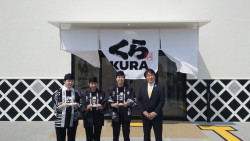
Originally published on metropolis.co.jp on April 2012

Under the onslaught of globalization and modernization, every corner of the world has been changing dramatically at an unprecedented pace. Consequently, many social problems have cropped up, such as the homogenization of indigenous cultures, and the effect on people of rapid technology development. However, the Japanese seem to have survived and developed better in the modern age, due to the unique national character rooted in their genes. In essence, it is the philosophy of mottainai—a term meaning a regretful sense of waste when the intrinsic value of an object or resource is not fully utilized.
To my understanding, mottainai has two connotations:
1. People should not take for granted what nature endows them with, and have some shame in resource consumption;
2. Given limited resources, people should make full use of everything available.
Wangari Maathai, a Kenyan environmentalist who won the Nobel Peace Prize in 2004, has introduced this Japanese concept to the rest of the world, roughly translated into English as “reduce, reuse, and recycle.”
I once paid an unforgettable visit to Tokoname, a noted pottery-producing region, where I was amazed to find that local people manage to fully utilize pottery products and kiln tools in their daily life. They use them with great care; such products as pots and bowls are not cast away easily if broken, instead mended for further use. Moreover, pottery scraps, defective pottery products, and unusable kiln tools are widely used as road embankment, building and pavement material, and so forth. This traditional practice of cherishing things is in sharp contrast to today’s throw-away culture in the age of mass production, in which the velocity of advancement causes people to update their products rapidly.
Last year I visited a Toyota factory, and found the mottainai concept also embodied in something called JIT. The JIT (“just in time”)—or kanban—system, has revolutionized the car industry since first adopted by Toyota in the 1950s. Its fundamental principle is that a company can save money on parts and components by not having to store them. In the JIT system they are delivered to the assembly line just in time to be installed in the car. Nothing is produced until needed, in order to reduce waste. Japan has limited and thus precious land resources. Therefore, Toyota as well as other car makers couldn’t afford to use large expanses of land as warehouses to store parts. Before the 1950s, this unique precondition for Japanese car makers was thought to be a disadvantage. Yet, in the 1950s the Toyota chief engineers realized another way was possible. In fact, the JIT solution—born out of necessity—helped Toyota become one of the world’s leading automobile brands.
The secondhand goods market also prospers in Japan. A friend once told me that if you learn how to buy secondhand goods in Japan, you get as many quality items as you want to, at a reasonable price. Most importantly, you can lead a sustainable life by refusing to buy unnecessary new products. I took my friend’s lesson to heart. I have been able to get a Nikon D90 camera at a reasonable price with a guarantee in a secondhand camera shop in Chiba City, a like-new secondhand Casio Japanese e-dictionary from the online store Kakaku, a bunch of valuable out-of-print books in Jimbo, and that’s just to start with. Mottainai explains everything—people cherish things and try to make the utmost use of them.
Mottainai also refers to the promotion of appropriate development with appropriate technology. The first impression that comes to many people’s mind of Japan might be its advanced technology. However, in such a supposed high-tech country, it was only in July this year people began to enjoy digital instead of analog TV. You should know that digital TV was available three years ago in my hometown village in China! There are not as many skyscrapers in Japan as I first expected; the shinkansen high-speed rail link is still in use here after several decades while the high-speed trains in China are already faster and newer. However, I often wonder which development model is healthier and better. Certainly, the much more constrained, stable and sustainable development model of Japan, which has less unnecessary waste.
The concept of mottainai is deeply rooted in Japanese culture and affects every aspect of Japanese people’s life. In this era of globalization and modernization, Japan has set an excellent example of how to balance tradition and modernity, preserve indigenous culture while keeping pace with the rest of the world, and develop appropriately—not too fast or slow—with appropriate technology, all while making full use of its resources and avoiding unnecessary waste.
Have something to say about this story? Share your comments below.







